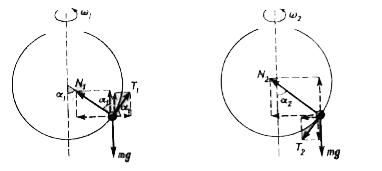A spherical bowl of radius R rotates about the vertical diameter. The bowl contains a samll object whose radius vector in the course of rotation makes an angle α with the vertical (Fig.). What should be the minimum angular velocity ω of the bowl in order to prevent the object from sliding down, if the coefficient of static friction is μstat?

The correct Answer is:√gtan(α−φ)Rsinα≤ω≤√gtan(α+φ)Rsinα, where φ=arc tanμ
Since the object is at rest, the direction of the force of friction is not known. For this reason we shall imagine the angular velocity to be decreased until the object starts sliding downwards. The force of friction will then be directed as shown in Fig. The equations of motion are of the form
Nsinα−Tcosα−mω2Rsinα
NCosα∣Tsinα−mg=0
where T=μstat=tanφ we obtain after some simple transformations
ω1=√gtan(α−φ)Rsinα
Suppose we imagine the angular velocity to be increased, so that the object starts sliding upwards. Then the direction of the force of 
friction will change sign (Fig.) and the equations of motion will assume the form
Nsinα+Tcosα=mω2Rsinα
Ncosα−Tsinα−mg=0
T=μstatN=Ntanφ
from which we get
ω2=√gtan(α+φ)Rsinα
Thus the body will be in equilibrium if
√gtan(α−φ)Rsinα≤ω≤√gtan(α+φ)Rsinα
Obviously, if α≤φ, i.e. if tanα≤μstat, the object will not slide down, even when the bowl stops rotating.
As a particular case of the solution when static friction is absent (μstat=tanφ=0) equilibrium will be established when the bowl rotates at an angular velocity of
ω0=√g/Rcosα
Similar Questions
A hemispherical bowl of radius (R) is set rotating about its axis of symmetry which is kept vertical. A small block kept in the bowl rotates with bowl without slipping on its surface. If the surface of bowl is smooth, the angle made by the radius through the block with the vertical is θ. the angular speed at which the bowl is rotating
View SolutionA semicircular bowl of radius R is symmetrical to the axis that is rotating vertically relative to it. The ball placed in the bowl rotates without slipping on the surface of the bowl itself. If the surface of the bowl is smooth and the angle formed by the radius from the ball with the hoist alpha The bowl is completing
View SolutionA hemispherical bowl of radius R si set rotating abouv its axis of symmetry whichis kept vertical. A small blcok kept in the bowl rotates with the bowl without slippingn on its surface. If the surfaces of the bowl is mooth, and the abgel made by the radius through the block with the vertical is θ, find the angular speed at which the bowl is rotating.
View SolutionA hemispherical bowl of radius R is set rotating about its axis of symmetry which is kept vertical. A small block kept in the bowl rotates with the bowl without slipping on its surface. If the surface of bowl is smooth, and the angle made by the radius through the block with the vertical is q, the angular speed at which the bowl is rotating is
View SolutionA hemispherical bowl of radius R is set rotating about its axis of symmetry which is kept vertical. A small block kept in the bowl rotates with the bowl without slipping on its surface. If the surface of bowl is smooth, and the angle made by the radius through the block with the vertical is q, the angular speed at which the bowl is rotating is
View SolutionA hemispherical bowl of radius R si set rotating about its axis of symmetry which is kept vertical. A small block kept in the bowl rotates with the bowl without slipping on its surface. If the surfaces of the bowl is smooth, and the angle made by the radius through the block with the vertical is θ, find the angular speed at which the bowl is rotating.
View SolutionA hemispherical bowl of radius R si set rotating abouv its axis of symmetry whichis kept vertical. A small blcok kept in the bowl rotates with the bowl without slippingn on its surface. If the surfaces of the bowl is mooth, and the abgel made by the radius through the block with the vertical is θ, find the angular speed at which the bowl is rotating.
View Solution
